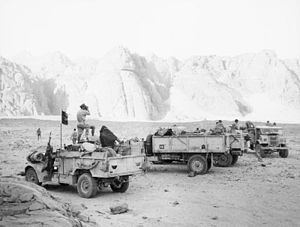Dates 13 Sep 1942 – 19 Sep 1942 | Result Axis victory | |
 | ||
800 killed and 576 captured1 cruiser2 destroyers4 MTBs2 MLsSeveral landing craft 15 Italians and 1 German killed43 Italians and 7 Germans wounded30 aircraft Combatants Similar World War II, Operation Abstention, Bardia raid, Operation Flipper, Raid on Algiers | ||
Operation agreement
Operation Agreement comprised a series of ground and amphibious operations carried out by British, Rhodesian and New Zealand forces on Axis-held Tobruk from 13–14 September 1942, during the Second World War. A Special Interrogation Group party, fluent in German, took part in missions behind enemy lines. Supporting attacks extended to Benghazi (Operation Bigamy a.k.a. Snowdrop), Jalo oasis (Operation Nicety a.k.a. Tulip) and Barce (Operation Caravan a.k.a. Hyacinth). Attacking without air cover, the Tobruk raid was a disaster. The British force lost several hundred killed and captured, three warships, seven motor torpedo boats and dozens of small amphibious craft.
Contents
- Operation agreement
- Operation agreement italians sink hms sikh capture 600 brit commandos
- Targets
- Prelude
- Main attack
- References
Operation agreement italians sink hms sikh capture 600 brit commandos
Targets
The objective of Operation Agreement was to undermine the Axis war effort in North Africa by destroying airfields, harbour facilities, ships, vehicles and large oil stores. The Allies also intended to capture Jalo oasis, which was to be used as a gathering point for the retreating ground forces involved in the other operations.
Prelude
G1 and T1 patrols of the Long Range Desert Group (LRDG) with 50 men, 12 light trucks, 5 jeeps assaulted Barce airfield and the main barracks, destroying 16 aircraft and damaging seven more. In the attack on the barracks the LRDG lost 4 men and 2 vehicles. Later near Zaptié the LRDG force was intercepted by an Italian motorized company with all vehicles damaged or destroyed, with the exception of 2 trucks which were loaded with the most seriously injured, while the others went on foot for 160 km. The Italians took 10 prisoners (7 New Zealanders and 3 Rhodesians), all injured. After a year 4 of the New Zealanders were able to escape.
The Special Air Service (Lieutenant Colonel David Stirling), supported by S1 and S2 patrols of the LRDG, were to attempt a big raid on Benghazi but after running behind schedule, their presence was discovered after a clash at a roadblock as dawn broke. With the element of surprise lost and the protection of darkness receding, Stirling ordered a withdrawal. The attack on Jalo oasis was carried out by the Sudan Defence Force and S1 and S2 patrols of the LRDG. The first attack on the night of 15/16 September, was easily repelled by the defenders, who had been alerted to the operation and had been reinforced. The attackers withdrew on 19 September, as an Italian relief column approached the oasis.
Main attack
British Commandos from the submarine HMS Taku, failed to set up beacons on the shore to guide the main British force, due to bad sea conditions. The expected garrison had been strengthened and British destroyers bringing in the seaborne troops, landed them on the wrong beach, far to the west of the intended one. Another landing by motor launches and boats, carrying Argyll and Sutherland Highanders and Royal Northumberland Fusiliers (whose Vickers medium machine guns were to take care of perimeter defence) partially failed to reach the planned landing point. Because of extremely heavy fire, only two MTBs made it into the target cove. One became stranded in the shallow water, the other managed to land Sergeant "Dusty" Miller and his group of Fusiliers, all of whom went "into the bag".
Allied strength for Operation Agreement involved an amphibious force of about 400 Royal Marines, 180 Argyll and Sutherland Highlanders under Captain Norman MacFie, 14 platoon of Z Coy, 1 Bn Royal Northuberland Fusiliers led by Lieutenant Ernest Raymond, army engineers and about 150 SAS approaching from the desert. Losses amounted to about 300 Royal Marines, 160 soldiers, 280 sailors, one light cruiser (HMS Coventry), two destroyers (HMS Sikh and Zulu), two motor launches, four MTBs and several small craft. MTB 314, a motor torpedo boat that was damaged and ran aground during the battle, was captured by the German harbour minesweeper R-10 at dawn, with 117 seamen and soldiers on board. Dozens of British seamen and marines were rescued from the sea by the Italian Spica-class torpedo boat Castore, the Generali-class Montanari, the armed tug Vega, a flotilla of German harbour minesweepers and several Italian and German motor barges. A couple of makeshift motor amphibious craft, attempting to reach Alexandria at very low speed were also captured with their crews. Although they were frequently dive bombed during their return journey, some of the MTBs, including Raymond's, reached Alexandria. The Royal Marines suffered 81 killed and the Royal Navy destroyers Sikh and Zulu and the cruiser Coventry reported the loss of another 217 men. About 576 British survivors were captured. Axis losses were 15 Italians and 1 German killed and 43 Italians and 7 Germans wounded.
The British destroyer Sikh, according to the survivors, had been hit by Italian 155 mm (6-inch) shore batteries and German 88 mm antitank guns while taking on troops. Zulu had gone to the rescue but was unable to pull Sikh clear, which eventually sank; 115 crew were reported killed and the survivors were taken prisoner. On the afternoon of 14 September, while returning to Alexandria Coventry was badly damaged by German dive bombers from Crete, in which 63 crew were killed, leading to her being scuttled by Zulu. Zulu was hit by Italian fighter-bombers a little later and needed assistance. While under tow and 100 nautical miles (120 mi) from Alexandria Zulu sank with the loss of 39 crew.
